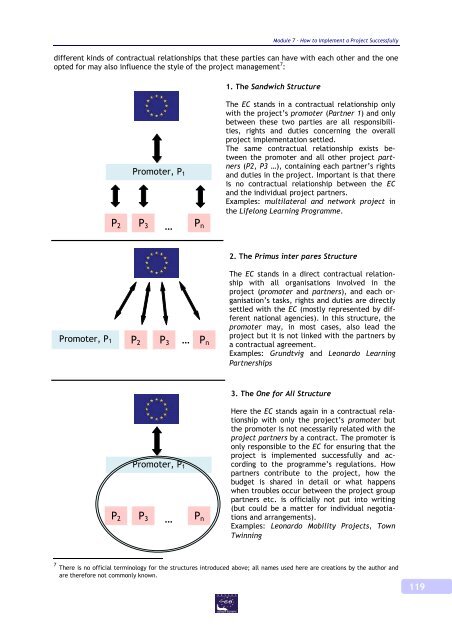We All are Europe - AESAEC
We All are Europe - AESAEC
We All are Europe - AESAEC
Create successful ePaper yourself
Turn your PDF publications into a flip-book with our unique Google optimized e-Paper software.
Module 7 – How to Implement a Project Successfully<br />
different kinds of contractual relationships that these parties can have with each other and the one<br />
opted for may also influence the style of the project management 7 :<br />
1. The Sandwich Structure<br />
Promoter, P 1<br />
P 2 P 3 … P n<br />
The EC stands in a contractual relationship only<br />
with the project’s promoter (Partner 1) and only<br />
between these two parties <strong>are</strong> all responsibilities,<br />
rights and duties concerning the overall<br />
project implementation settled.<br />
The same contractual relationship exists between<br />
the promoter and all other project partners<br />
(P2, P3 …), containing each partner’s rights<br />
and duties in the project. Important is that there<br />
is no contractual relationship between the EC<br />
and the individual project partners.<br />
Examples: multilateral and network project in<br />
the Lifelong Learning Programme.<br />
2. The Primus inter p<strong>are</strong>s Structure<br />
Promoter, P 1 P 2 P 3 … P n<br />
The EC stands in a direct contractual relationship<br />
with all organisations involved in the<br />
project (promoter and partners), and each organisation’s<br />
tasks, rights and duties <strong>are</strong> directly<br />
settled with the EC (mostly represented by different<br />
national agencies). In this structure, the<br />
promoter may, in most cases, also lead the<br />
project but it is not linked with the partners by<br />
a contractual agreement.<br />
Examples: Grundtvig and Leonardo Learning<br />
Partnerships<br />
3. The One for <strong>All</strong> Structure<br />
Promoter, P 1<br />
P 2 P 3 … P n<br />
Here the EC stands again in a contractual relationship<br />
with only the project’s promoter but<br />
the promoter is not necessarily related with the<br />
project partners by a contract. The promoter is<br />
only responsible to the EC for ensuring that the<br />
project is implemented successfully and according<br />
to the programme’s regulations. How<br />
partners contribute to the project, how the<br />
budget is sh<strong>are</strong>d in detail or what happens<br />
when troubles occur between the project group<br />
partners etc. is officially not put into writing<br />
(but could be a matter for individual negotiations<br />
and arrangements).<br />
Examples: Leonardo Mobility Projects, Town<br />
Twinning<br />
7 There is no official terminology for the structures introduced above; all names used here <strong>are</strong> creations by the author and<br />
<strong>are</strong> therefore not commonly known.<br />
119









